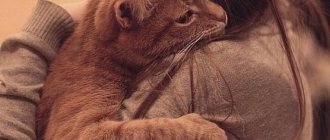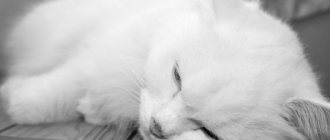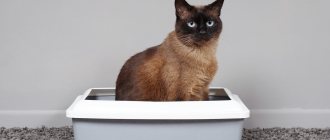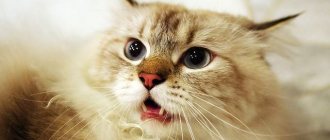40580Administration
11
Unfortunately, nothing in the world lasts forever and death accompanies us throughout our lives. Of course, the loss of a loved one cannot be compared with the departure of another cat into the world. But sometimes you become so attached to your beloved pet that you consider it a member of the family.
Owners rarely have to watch cats die. And all because most of them prefer to face death far from home, completely alone. But this does not always happen, since not everyone has the opportunity to go outside. To understand that the cat is dying and the time has come to let him go on his last journey, specific symptoms of his approaching death will help. After all, it is important to provide proper care for him during this difficult period.
Causes of death of cats
The lifespan of pets is much shorter than humans. There are not many causes of death for cats:
- natural – death from old age;
- from illness;
- sudden death as a result of an accident.
You can prepare for the first two reasons and alleviate the suffering of your pet. The sudden death of a cat occurs suddenly; it is impossible to know about it in advance. It is experienced much more acutely than the death of an animal due to natural causes.
From old age
On average, domestic cats live 12–15 years. Cats die of old age at 10–11 years of age, but they can live much longer and die at the age of 20. It all depends on the breed and individual characteristics of the animal.
Interesting! Outbred cats live especially long, since their genetic apparatus has not been damaged by inbreeding.
If the cat's age has passed the 13-year mark and he becomes less active and sleeps a lot, we can conclude that his life's journey is coming to an end. By human standards, this is almost 70 years of age.
Each subsequent year of life is plus 7 years. An animal dying of old age does not experience pain: it gradually loses its vitality and fades away.
If a cat dies at home, a caring owner should provide her with peace and good care.
From illness
Diseases that threaten the life of a cat:
- Infections. They take first place among the reasons from which an unvaccinated kitten can die. Free-ranging cats are also at risk. An animal can also become infected during a planned mating if the partner is sick. The owners may not be aware of this circumstance if the disease occurs in a latent (hidden) form.
- Kidney failure is a consequence of castration and sterilization and significantly shortens the life of cats. The disease is treatable if noticed in time. In its advanced form, it will lead to the death of the cat.
- Oncology. Unfortunately, animals also often die from cancer. The risk of this disease is especially high in adult cats, but cancer is increasingly being diagnosed in young cats.
How to bury a pet, will it be possible to rebury it?
Owners of deceased pets are forced to decide how to bury their tailed family member. If the cat’s owner resorted to the procedure of euthanasia, the veterinary clinic will offer to bury it themselves, or, more precisely, cremate it. In other cases, in order to bury a cat, you will have to contact a veterinarian and act in accordance with his instructions.
In Russia, burying animals in the ground is prohibited by law. The corpses of animals and birds are equated to biological waste and are disposed of in accordance with the order of the Chief State Veterinary Inspector of the Russian Federation dated December 4, 1994 No. 13-7-2/469. According to this order, corpses are disinfected and burned.
Cremation of a cat
In some municipalities, special places are allocated for burying pets. To bury a pet in such a cemetery, the owner must present a veterinary certificate in form No. 4. The animal's corpse will be opened, the cause of death will be determined, and if it was not the result of an infection, it will be buried without being burned. Otherwise, the body will be disinfected, cremated and only then buried.
It is impossible to rebury a pet without breaking the law. For violating the requirements of the law, a loving owner who buried his deceased pet in a yard or forested area risks paying a fine of 5,000 rubles.
Signs that a cat is dying
You can understand that a cat is dying by certain signs long before this sad event. Changes in behavior and appearance will tell the owners of a dying cat that its departure is inevitable.
Lack of appetite
One of the signs of illness or imminent death is loss of appetite. The cat first loses interest in food, eats without pleasure, and then stops eating altogether. Refusal of water for several days is a signal that the cat is dying.
The following symptoms should also raise alarm:
- an empty litter tray is evidence of a failure of the gastrointestinal tract;
- black bowel movements and vomiting indicate internal bleeding;
- dark urine - the kidneys cannot cope with filtration.
The consequences of an eating disorder will not keep you waiting - restoration of the body will be impossible.
Labored breathing
The accumulation of fluid in the lungs is a consequence of metabolic disorders and kidney failure. Breathing becomes frequent and shallow. Even with minor physical exertion, the cat develops shortness of breath.
Slow heart rate
Due to a malfunction of the excretory system and dehydration, the blood thickens. The heart has difficulty pumping it through the vessels that have lost their tone and begins to malfunction. The pressure drops and the heart rate decreases.
The normal heart rate of a healthy cat is 120–140 beats per minute. In a dying animal it will be uneven and weak. To determine the heart rate, you need to place your palm under the cat's left paw.
Specific smell
The cat's body weakens before death, waste and toxins are not eliminated through the intestines and urinary system. Metabolic products are released along with sweat, exhaled air, through the mucous membranes. An unpleasant odor begins to emanate from the cat. The appearance of this sign indicates that the pet will die soon.
Reduced temperature
Body temperature drops due to the decline of vital functions. Normally, the thermometer readings should not be lower than 37.7°C. If this value gradually becomes lower, the cat dies.
Important! This sign of imminent death can be determined without a thermometer. You need to touch the paw pads of the animal: they are cold on a dying cat.
How to come to terms with loss
It is not always easy to identify the symptoms of a sick animal. However, diarrhea, cramps, vomiting, and blood in the urine are signs that the cat is dying.
Very often, in the last days of life, cats stop eating and drinking. A pet can turn away even from its most favorite treat. If a pet dies due to illness, refusing food will only worsen the condition, but you will not be able to force-feed it.
For the owner of a beloved pet, the death of an animal is a very painful process. To prevent such a sad outcome, it is important to closely monitor the cat’s health and respond to dangerous symptoms. Sometimes only an experienced doctor can notice the signs of an incipient disease. That's why it's worth visiting a veterinarian periodically to have your pet examined. Remember, providing timely medical care can save his life.
Similar
Stages of death
Death is not an instant, but a process that gradually turns off the body, passing it through the following stages:
- Preagonia - loss of consciousness, cessation of blood circulation, pallor and cyanosis of the skin. This stage can last from several minutes to an hour.
- Terminal pause (preagonia). Breathing practically stops, pressure drops to zero. The oculomotor reflex disappears.
- Agony. Characterized by a lack of consciousness and tactile sensitivity. Breathing may resume and blood pressure may rise. Convulsions may occur.
- Clinical death. Complete stop of all vital processes. When carrying out resuscitation measures, it is possible to “start up” the cat’s body. The duration of the period is about 8 minutes.
- Biological death. This stage is irreversible and is characterized by the complete cessation of all physiological processes in the cat.
Birth trauma and birth defects
Early mortality is often associated with oxygen starvation of the body due to delay in the birth canal or late opening of the fetal membrane. A female giving birth for the first time may need human assistance. This is especially important if labor is prolonged.
Experience shows that resuscitation of a newborn kitten without signs of life does not give positive results. Lack of oxygen immediately after birth has fatal consequences: serious damage to the nervous system and brain of the baby. It is also very difficult to resuscitate premature kittens.
Anomalies that cause death:
- cleft palate;
- absence of anus;
- navel hernia;
- cleft lip;
- skeletal deformity;
- disorders of blood supply and cardiovascular activity;
- respiratory system defects;
- absence of organs.
If the birth of children with serious pathologies recurs, the female should be sterilized.
You can bring a baby back to life in the following cases:
- the baby was born with low body weight;
- the baby’s cranial bones or ribs are deformed;
- one or more limbs are missing.
Making a decision about the need for resuscitation measures falls entirely on the shoulders of the animal owner. It should be taken into account that a cat with congenital defects will have reduced immunity.
In addition to these reasons, the death of a newborn may be a consequence of an infection transmitted in the womb of the mother.
Photo - British kittens after eating
Behavior of cats before death
Before death, cats behave strangely, and it is impossible not to notice.
Cats leave home to die elsewhere. If the pet is free-range, then it has this opportunity. Many owners say that before leaving, an elderly or sick cat would cuddle and purr in a special way.
It is not difficult to track signs of imminent death if a cat dies of old age or a long-term illness and is in an apartment with its owners:
- Eating disorder. The cat seems to forget why it comes to the feeding place. She can sit near a bowl of food or water for a long time and never touch it.
- Loss of control over physiological functions. An older cat suddenly begins to empty his bowels and bladder outside the litter box.
- The cat constantly changes its resting place: it can lie down in a passable place or hide in dark, cramped corners.
- Disorder of the cat's motor functions: unsteadiness of gait, aimless walking around the house, loss of coordination.
- Constant meowing. This is how the cat tries to attract the owner’s attention and asks him to help.
- The pet stops performing “cat litter” - licking itself.
- The cat sleeps a lot.
Sunken eyes, dull fur, sudden weight loss, lethargy and apathy should alert the owner. A veterinarian's examination and palliative treatment will help prolong the cat's life if it is seriously ill.
Eliminating negativity
If your pet has died and you are afraid of unpleasant consequences, you need to take some actions that will save you from upcoming troubles and troubles. These simple steps will help you send your pet off with dignity. It is best to bury it in a quiet place. After this, you should wash your hands well and wash yourself with cold water, as if you were washing away all the negativity and troubles that could overtake your cat.
It would not be superfluous to sprinkle your home with holy water, light a candle and say:
Burn and burn, you know what.
A great way to avoid disaster is to adopt a kitten. In this way, you will do a good deed by providing the animal with a reliable home, but you will also have a reliable protector.
The death of a beloved cat causes stress for everyone in the household. At such moments, a person needs positive emotions and colorful impressions. You can try to refresh your memory of happy moments by remembering the antics of your cat. The main thing is that you don’t need to scare yourself or look for bad omens. All living things die, your pet is no exception. If he died at home, this does not always bring trouble for the owners. In this way the cat could protect its owners.
Is it humane to euthanize a pet?
The question of the necessity and humanity of euthanasia in relation to a dying cat is decided by its owner. It is very difficult to decide to euthanize your pet, almost a family member.
The arguments for resolving this problem are:
- incurability of the disease;
- the suffering the animal experiences;
- the inevitability of painful death.
Euthanasia will help reduce the time of agony and make the process of leaving the cat quick and painless.
You can refuse this procedure in favor of taking strong painkillers. In this case, the cat will not feel pain, but will remain unconscious until the very end.
In modern veterinary clinics, animals are euthanized for health reasons and with the consent of the owner. First, the cat is given anesthesia and falls asleep. Then a drug is injected that stops breathing and heart function.
How can we help?
How to help a dying cat? Just like a person. Make her last days and hours calm and happy. There is no need to cry or otherwise irritate the dying woman. Let these hours, the last ones next to your beloved, be filled with light sadness, like a calm autumn day, and not a storm.
In addition to warmth and being surrounded by love, you need to provide your pet with everyday comfort. If the cat no longer walks, absorbent diapers are required. A dry shampoo that does not require rinsing will come in handy to keep your animal's fur clean. You also need to take care of the absence of drafts. Of course, they will no longer affect the health, but will cause significant discomfort to the pet.
You should not assume that a cat cannot be picked up or otherwise disturbed. This moment depends on her state and on her internal intuitive feeling. If you want to take your pet home and watch a movie with her, that’s what you need to do.
What to do after the death of an animal
Despite the pain of loss, the owner of the deceased cat has urgent matters to complete. If a cat dies on the street or at home, you need to bury it yourself. This can be done on your own property, in the forest or in an animal cemetery.
Cats that die in veterinary hospitals are buried by special services. The owner pays for the service, says goodbye to the pet and leaves the body in the hospital.
About refusing to drink and eat
Refusal of both food and water is one of the main harbingers of imminent death, which is what animal owners most often focus on. This is true; some time before its death, the pet stops eating and refuses water. Even if you offer something tasty and favorite, there will be no reaction.
Refusal to eat and drink causes the animal to look emaciated and lose weight. The cat's stomach drops. This point is important. If a cat’s tummy is swollen, you should immediately take your pet to the clinic or call a doctor to her house, rather than grieve.
Complications leading to the death of a kitten
Kittens that have suffered birth trauma or intrauterine infection are at risk. Low weight and a weakened body will not allow such a baby to withstand competition with its brothers in the fight for mother's milk.
The respiratory processes of a sick cat are inhibited, the sucking reflex is weak, the body temperature drops below normal, the functioning of the circulatory system slows down, and then motor activity is lost. These processes irreversibly lead to convulsions, coma and death.
Dehydration
A kitten's kidneys are underdeveloped (compared to an adult animal) and excrete a large amount of fluid. Therefore, the body of a cat baby needs a constant supply of moisture. If the baby eats sluggishly or shows symptoms of diarrhea, this is a harbinger of impending dehydration. Weight loss is caused by fluid loss. Other signs of dehydration:
- dry mouth;
- bright pink color of the tongue and mucous membrane;
- flabby body muscles;
- drop in physical activity.
Symptoms of dehydration indicate the need to provide additional nutrition for the baby. Your veterinarian may recommend saline injections.
Hemolysis
Hemolysis is a disease caused by an unfortunate combination of the blood types of the father and mother of the cub. From the moment of birth, the kitten’s body begins to destroy foreign red blood cells. Antibodies that enter the bloodstream with mother's milk are responsible for this protective process.
Each blood group (A, B or AB) has its own type of antibodies. At the same time, antibodies of group B are hostile (bind) to red blood cells of group A. If the baby has inherited the paternal blood group A or AB, then the antibodies obtained with mother's milk (type B blood) will lead to the destruction of red blood cells, the development of anemia and complete metabolic disorders in the body.
The process of breakdown of red blood cells is especially active in the first days after birth. As a measure to protect babies at risk, they are bottle-fed formula for the first 16 hours. After this time, the walls of the baby’s intestines become stronger and stop allowing antibodies into the blood. The negative consequences of such precautions are due to the fact that in the first hours the baby’s body receives globulins, which are responsible for the state of the body’s immune system.
If it is not possible to determine the baby’s blood type, you can look at the color of the baby’s urine after the first reduced intake of mother’s milk. A brown tint will indicate problems with antibodies. To minimize the risk of hemolysis, breeders adhere to the following rules: cats with blood type B can be crossed with any partners, cats with blood type A can be bred with any cats. Cats with type A are only allowed to mate with animals of the same blood group.
Conjunctivitis
Kittens' eyelids remain closed until ten days after birth. If there are minor injuries, pathogenic bacteria and viruses can enter the sinus between the eyelid and the eye. If the eyelids are swollen and red, and purulent discharge flows from the eye, there is a reason to consult a veterinarian. Among the causes of such symptoms may be intrauterine infection with viral herpes.
Usually the disease affects several babies at once. To treat the eyelids, you need to peel them apart, wash your eyes with a two percent solution of boric acid and take a course of antibiotic treatment (in drops).
Brits crawl into a ball to stay warm
Maternal factor
One of the causes of mortality is maternal misbehavior. It happens that a mother eats the weakest child in order to feed the rest of the offspring. This instinct was a feline inheritance from wild relatives. If a domestic cat has eaten the entire litter, the female must be spayed, otherwise this will happen again in the future.
An inexperienced mother can leave her children alone for a long time, in which case the pets develop hypothermia.
Insufficient quantity or low fat content of milk can also disrupt the normal development of children. The reason is too young age, exhaustion or obesity of the woman in labor.
Photo of a warm playpen with newborn kittens










